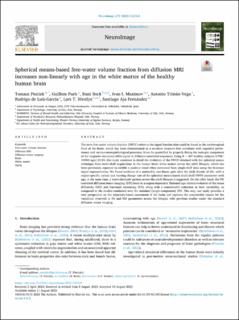| dc.description.abstract | The term free-water volume fraction (FWVF) refers to the signal fraction that could be found as the cerebrospinal fluid of the brain, which has been demonstrated as a sensitive measure that correlates with cognitive performance and various neuropathological processes. It can be quantified by properly fitting the isotropic component of the magnetic resonance (MR) signal in diffusion-sensitized sequences. Using
healthy subjects (178F/109M) aged 25-94, this study examines in detail the evolution of the FWVF obtained with the spherical means technique from multi-shell acquisitions in the human brain white matter across the adult lifespan, which has been previously reported to exhibit a positive trend when estimated from single-shell data using the bi-tensor signal representation. We found evidence of a noticeably non-linear gain after the sixth decade of life, with a region-specific variate and varying change rate of the spherical means-based multi-shell FWVF parameter with age, at the same time, a heteroskedastic pattern across the adult lifespan is suggested. On the other hand, the FW corrected diffusion tensor imaging (DTI) leads to a region-dependent flattened age-related evolution of the mean diffusivity (MD) and fractional anisotropy (FA), along with a considerable reduction in their variability, as compared to the studies conducted over the standard (single-component) DTI. This way, our study provides a new perspective on the trajectory-based assessment of the brain and explains the conceivable reason for the variations observed in FA and MD parameters across the lifespan with previous studies under the standard diffusion tensor imaging. | en_US |

